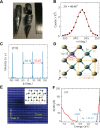Thermoelectric Figure-of-Merit of Fully Dense Single-Crystalline SnSe
- PMID: 31459709
- PMCID: PMC6648424
- DOI: 10.1021/acsomega.8b03323
Thermoelectric Figure-of-Merit of Fully Dense Single-Crystalline SnSe
Abstract
Single-crystalline SnSe has attracted much attention because of its record high figure-of-merit ZT ≈ 2.6; however, this high ZT has been associated with the low mass density of samples which leaves the intrinsic ZT of fully dense pristine SnSe in question. To this end, we prepared high-quality fully dense SnSe single crystals and performed detailed structural, electrical, and thermal transport measurements over a wide temperature range along the major crystallographic directions. Our single crystals were fully dense and of high purity as confirmed via high statistics 119Sn Mössbauer spectroscopy that revealed <0.35 at. % Sn(IV) in pristine SnSe. The temperature-dependent heat capacity (C p) provided evidence for the displacive second-order phase transition from Pnma to Cmcm phase at T c ≈ 800 K and a small but finite Sommerfeld coefficient γ0 which implied the presence of a finite Fermi surface. Interestingly, despite its strongly temperature-dependent band gap inferred from density functional theory calculations, SnSe behaves like a low-carrier-concentration multiband metal below 600 K, above which it exhibits a semiconducting behavior. Notably, our high-quality single-crystalline SnSe exhibits a thermoelectric figure-of-merit ZT ∼1.0, ∼0.8, and ∼0.25 at 850 K along the b, c, and a directions, respectively.
Conflict of interest statement
The authors declare no competing financial interest.
Figures






References
-
- Liu Y.; Zhou M.; He J. Towards Higher Thermoelectric Performance of Bi2Te3 via Defect Engineering. Scr. Mater. 2016, 111, 39–43. 10.1016/j.scriptamat.2015.06.031. - DOI
LinkOut - more resources
Full Text Sources
Miscellaneous
